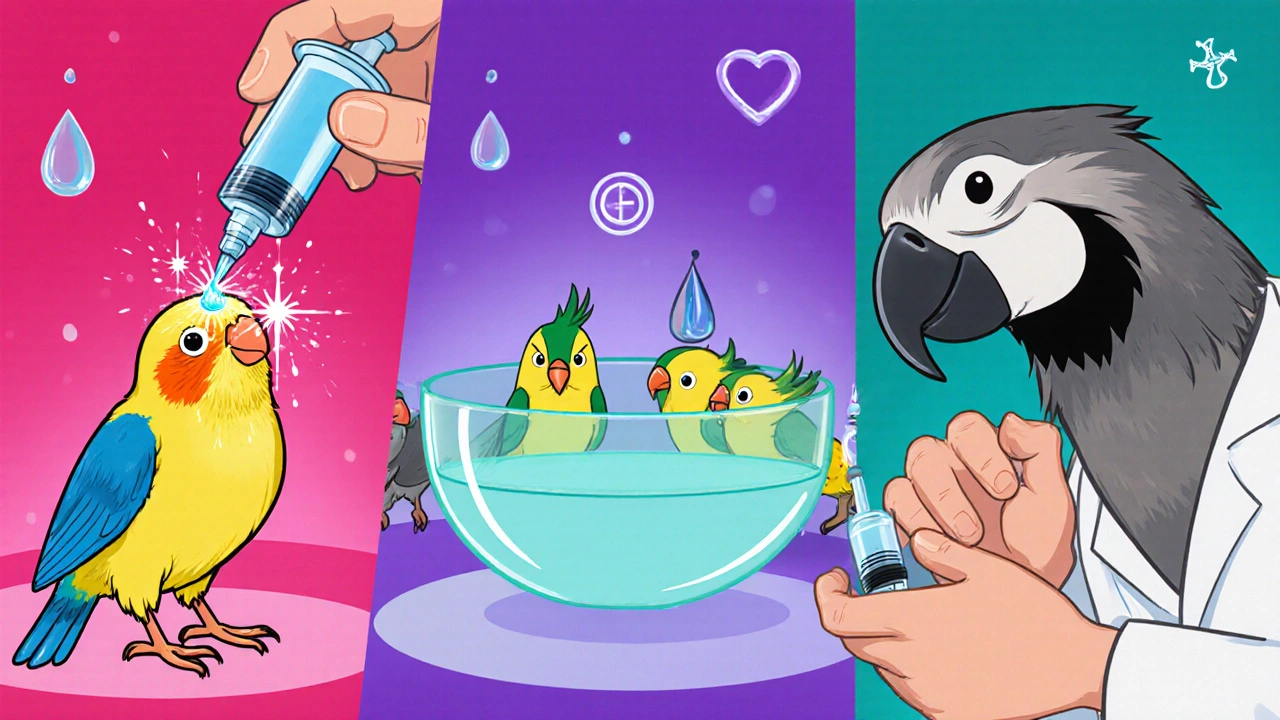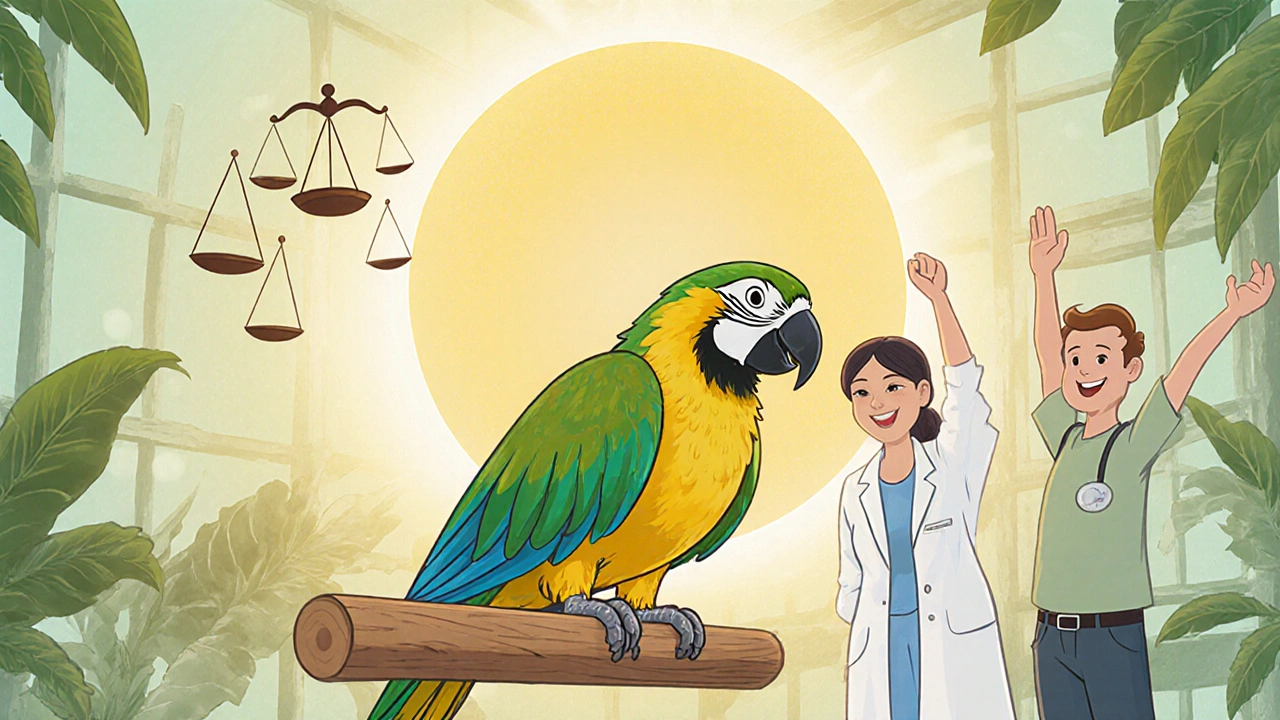Bird Ivermectin Dosage Calculator
Safe Ivermectin Dosage Calculator
Calculate the correct ivermectin dosage for your bird based on species and weight. Always consult with a veterinarian before administering medication.
Enter your bird's species and weight to see the recommended dosage range.
Ever wondered if the worm‑killing drug that’s been in the news for humans can safely help your feathered friends? ivermectin birds is a question many avian owners ask as parasite problems pop up. This guide walks you through what ivermectin actually is, how it works on birds, the right way to dose it, safety red flags, and some surprising extra benefits that veterinarians have observed.
Quick Takeaways
- Ivermectin is a broad‑spectrum antiparasitic approved for many bird species when prescribed by a vet.
- Correct dosage usually ranges from 0.2 to 0.5 mg/kg body weight, given orally or via drinking water.
- Side‑effects are rare but can include severe neurological signs if overdosed.
- Legal use varies by country; in the U.S. it is FDA‑approved for certain avian indications.
- Beyond parasite control, ivermectin may have anti‑inflammatory properties that some vets leverage for respiratory issues.
What Is Ivermectin?
Ivermectin is a macrocyclic lactone drug originally discovered in the late 1970s from a soil‑derived Streptomyces bacterium. It works by binding to chloride channels in nerve and muscle cells of invertebrates, causing paralysis and death of the parasite. Human medicine uses it for river blindness and scabies, while veterinarians rely on it for a wide range of internal and external parasites across livestock, pets, and exotic animals.
How Ivermectin Works Against Avian Parasites
The drug’s mechanism is the same in birds as in other animals: it opens glutamate‑gated chloride channels in the parasite’s nervous system, leading to hyperpolarisation and immobilisation. Because birds share similar physiological pathways, the drug can reach parasites lodged in the gut, lungs, or skin without harming the host-provided the dose stays within the therapeutic window.
Common Avian Parasites Treated with Ivermectin
Veterinarians frequently prescribe ivermectin for the following bird parasites:
- Coccidia - microscopic protozoa that cause watery droppings and weight loss.
- Mites (e.g., Knemidokoptes and Dermoptes) - external parasites that cause feather loss and skin irritation.
- Roundworms (ascarids) - large intestinal worms that can obstruct digestion.
- Lice - though less common, ivermectin can help when heavy infestations occur.
These parasites are often diagnosed through fecal floatation, skin scrapings, or visual inspection, and ivermectin offers a convenient, single‑dose solution for many owners.

Safe Dosage Guidelines for Different Bird Species
Dosage is the most critical factor for safety. Below is a quick reference table that most avian vets use. Always confirm the exact dose with your veterinarian, as individual health status and species variations matter.
| Bird Type | Weight Range | Recommended Dose | Administration |
|---|---|---|---|
| Parakeets (budgies) | 30‑60 g | 0.2 - 0.3 mg/kg (≈0.01 mg per bird) | Oral liquid or water medication |
| Canaries | 15‑30 g | 0.2 - 0.4 mg/kg | Water medication |
| Finches | 10‑20 g | 0.2 - 0.5 mg/kg | Oral syringe |
| Cockatiels | 80‑120 g | 0.3 - 0.5 mg/kg | Oral liquid |
| African Grey Parrots | 400‑600 g | 0.3 - 0.5 mg/kg | Oral liquid or subcutaneous injection |
| Raptors (e.g., kestrels) | 500‑1200 g | 0.4 - 0.6 mg/kg | Injection (preferred) |
Notice the dose range widens for larger birds and raptors. Over‑dosing can push ivermectin into the neurotoxic zone, especially in species that are more sensitive to the drug’s lipophilic nature.
Administration Methods: Oral, Water, or Injection
Choosing the right method depends on the bird’s size, temperament, and the parasite being targeted.
- Oral liquid - Most small‑to‑medium birds tolerate a few drops placed directly onto the tongue with a syringe. Alcohol‑free formulations are preferred.
- Water medication - Adding the calculated dose to the bird’s drinking water works well for flock treatments. Ensure the water is changed every 12 hours to maintain potency.
- Subcutaneous injection - Larger parrots and raptors often receive a single injection into the breast muscle. Only a licensed veterinarian should perform this.
Regardless of the route, mix the drug thoroughly and monitor the bird for any immediate adverse reactions.
Safety Concerns and Side Effects
When used correctly, ivermectin has a high safety margin in birds. Yet, several pitfalls can turn a harmless dose into a serious problem.
- Neurotoxicity: Over‑dose can cause tremors, ataxia, or even seizures. This is why precise weighing and dose calculation are non‑negotiable.
- Drug interactions: Ivermectin is metabolized by the liver enzyme CYP3A4. Concurrent use of other CYP3A4 inhibitors (e.g., certain antihistamines) can raise blood levels.
- Egg‑laying birds: High doses may temporarily suppress egg production, so breeders should discuss timing with their vet.
- Species sensitivity: Some exotic species, such as toucans or hornbills, have shown increased sensitivity; these birds often need a reduced dose (0.1 mg/kg).
If you notice any of these signs after treatment, contact a veterinarian immediately. Prompt supportive care-fluids, vitamin B complex, and anticonvulsants-can dramatically improve outcomes.

Legal and Regulatory Landscape
The U.S. Food and Drug Administration (FDA) has approved ivermectin for specific avian uses, mainly for controlling coccidiosis in poultry. For pet birds, the drug is considered “extra‑label” and must be prescribed by a licensed veterinarian under the Animal Medicinal Drug Use Act.
In Australia, the Therapeutic Goods Administration (TGA) mirrors the FDA stance: ivermectin can be used for birds only with a veterinary prescription. Importing ivermectin without proper documentation can lead to customs seizure.
Always verify that the product you buy is a veterinary‑grade formulation. Human‑grade tablets may contain excipients that are unsafe for birds.
Potential Benefits Beyond Parasite Control
Recent off‑label studies have hinted at a few extra perks of ivermectin in avian medicine:
- Anti‑inflammatory effects: Low‑dose ivermectin appears to modulate cytokine release, which some vets use to calm chronic respiratory inflammation in parrots.
- Antiviral activity: In vitro work with avian influenza viruses shows reduced replication at concentrations far above therapeutic levels. While not a treatment, it fuels research into combination therapies.
- Improved feather quality: Birds recovering from heavy mite infestations often show faster feather regrowth once the parasites are cleared, indirectly boosting overall health.
These findings are preliminary; never start your bird on ivermectin for these reasons without veterinary guidance.
Bottom Line
Ivermectin can be a powerful tool in the avian caretaker’s kit, but it demands respect for dosage, species‑specific quirks, and legal requirements. When used under a vet’s supervision, it clears coccidia, mites, roundworms, and more-keeping your feathered companion comfortable and thriving.
Can I give human ivermectin tablets to my bird?
No. Human tablets often contain fillers or higher concentrations that can be toxic to birds. Always use a veterinary‑grade formulation prescribed by a qualified avian vet.
How long does it take for parasites to disappear after treatment?
Coccidia oocysts typically drop within 3‑5 days, while mites may require a second dose after 7 days because of their life cycle.
Is ivermectin safe for my breeding pair?
Yes, if dosed correctly. However, inform your vet as you may want to avoid treatment during peak egg‑laying weeks to prevent temporary laying suppression.
What signs indicate an overdose?
Look for tremors, loss of balance, excessive drooling, or seizures. Immediate veterinary care is crucial.
Can I treat an entire flock with a single water dose?
Yes, but the water must be refreshed every 12 hours and the total dose calculated on the average weight of the flock. A vet should confirm the plan.


Kajal Gupta
October 23, 2025 AT 20:21Wow, this guide really paints a vivid picture of how ivermectin can be a lifesaver for our feathered companions. I love the clear dosage tables – they’re like a rainbow of safety for budgies, cockatiels, and even the majestic African Grey. It’s so reassuring to see the emphasis on veterinary‑grade formulations, because we definitely don’t want to mess up with human tablets. The safety red flags are spot on; nobody wants a shaky bird wobbling around the cage. Thanks for the thorough rundown – it feels like a friendly hand guiding us through the maze of parasite control.
Zachary Blackwell
October 25, 2025 AT 00:13Look, the usual story about ivermectin being a miracle drug is just the tip of the iceberg. Behind the scenes there’s a whole network of pharma pushers trying to keep us in the dark about off‑label uses, especially for birds. If you think the FDA’s approval is the whole truth, you’re being fed a curated narrative. The real power of ivermectin lies in its ability to bypass the mainstream pet‑care industry’s monopoly. Keep your eyes open and question why such a versatile drug is still labeled "extra‑label" for our avian friends.
prithi mallick
October 26, 2025 AT 03:16I find it fascinating how a single compound can bridge the gap between human health and avian wellbeing. It reminds me of the interconnectedness of all living beings – a tiny dose for a bird can echo larger themes of stewardship. The guide does a great job of balancing scientific detail with practical tips, even if a few minor typos slip through. Remember, every bird is unique, so listening to their subtle cues is as important as the numbers on the label. Thanks for the thoughtful compilation.
Michaela Dixon
October 27, 2025 AT 07:20The nuanced interplay between ivermectin's pharmacodynamics and avian physiology invites a deeper contemplation about the ethical responsibilities we bear as caretakers it is not merely a chemical but a bridge between our intentions and the fragile lives we nurture each dose carries with it a narrative of trust and vigilance the careful calibration of mg per kg becomes a meditation on precision and compassion when a bird regains its vigor after a mite infestation the joy is palpable and it underscores the importance of respecting the drug's potency the potential anti‑inflammatory benefits open a horizon of possibilities for chronic conditions yet they demand a measured approach not every species responds identically the cautionary tales of neurotoxicity serve as a sober reminder that ignorance can turn remedy into harm the dialogue between veterinarian and owner must be rooted in transparency and mutual respect as we navigate dosage calculations the underlying principle remains simple: prioritize the bird's holistic health over convenience the broader implication is that responsible use of ivermectin can enhance welfare while preserving the ecological balance within aviary communities
Dan Danuts
October 28, 2025 AT 11:23Great info!
Dante Russello
October 29, 2025 AT 15:26Thank you for such a comprehensive overview; the inclusion of species‑specific dosage ranges, administration methods, and safety considerations is truly invaluable, especially for novice avian enthusiasts, and the clear warnings about neurotoxicity, drug interactions, and species sensitivity provide essential guidance that can prevent serious complications, while the discussion of off‑label benefits, such as anti‑inflammatory and antiviral potentials, sparks curiosity for future research, all presented in an accessible format that balances technical detail with practical advice.
James Gray
October 30, 2025 AT 19:30Super helpful guide, definitely gonna share with my flock club – it’s definetly a game changer for our pet birds!
Shubhi Sahni
October 31, 2025 AT 23:33I appreciate the depth of information provided; the careful breakdown of dosage calculations, administration routes, and potential side‑effects is especially useful for bird owners who may be navigating these decisions for the first time, and the reminders about using veterinary‑grade formulations and consulting a qualified avian veterinarian reinforce best practices, ensuring both safety and efficacy in parasite management.